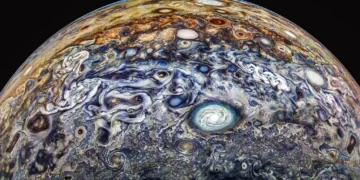NASA’s Juno spacecraft has surpassed expectations, venturing deeper into the heart of the Jupiter system than any probe before it. Since its arrival in 2016, Juno has revolutionized our understanding of the largest planet in our solar system—and it’s not done yet. In 2025, the spacecraft continues its extended mission, unveiling astonishing discoveries about Jupiter’s colossal polar cyclones and the violent, ever-changing surface of its volcanic moon, Io.
Jupiter’s Polar Cyclones: Immense, Stable, and Surprisingly Coordinated
Juno has delivered unparalleled insight into Jupiter’s atmospheric mechanics, particularly the massive cyclones spinning around its poles.
Through instruments like the Microwave Radiometer (MWR) and Jovian Infrared Auroral Mapper (JIRAM), scientists have captured extraordinary data from Jupiter’s poles, where swirling cyclones—each the size of Australia—dance in organized, long-lasting patterns. At the north pole, a central cyclone is surrounded by eight others, locked in a symmetrical arrangement. These cyclones are not transient like Earth’s hurricanes. Instead, they appear to be enduring features, stabilized by unique interactions.
The physics behind these formations is both complex and fascinating. According to Juno co-investigator Yohai Kaspi, these cyclones act like “springs in a mechanical system,” bouncing off one another to maintain a steady configuration. Their stability is partly explained by beta-drift and the dynamics of Coriolis forces at high latitudes.
Jet Streams and Hidden Weather Systems
Juno’s sensors have also revealed jet streams and thermal gradients unlike any seen on Earth, transforming the way scientists understand gas giant atmospheres.
By transmitting radio signals through Jupiter’s upper atmosphere and measuring how they bend and shift, scientists have gleaned data on temperature, density, and wind speeds within the cloud layers. One recent finding involved Jupiter’s north polar stratospheric cap, which was surprisingly warm—around 11°C (51°F)—and circled by 100-mph winds.
This discovery has important implications. It shows that Jupiter’s weather is not only violent and large-scale but also incredibly structured in unexpected places. The presence of warmth at the stratospheric cap, coupled with high-speed winds, reveals an interplay between solar heating, internal heat, and atmospheric circulation that was previously underestimated.
Io’s Volcanic Landscape: A Moon in Constant Eruption
Beyond the gas giant itself, Juno has also pulled back the curtain on Io—the most volcanically active body in the solar system.
On December 27, 2024, JIRAM captured imagery of an eruption more powerful than any previously observed on Io. A hotspot larger than Lake Superior near the south pole lit up in the infrared spectrum, revealing an eruption discharging massive amounts of energy and lava. This wasn’t an isolated event. Evidence suggests that 10% of Io’s surface is covered in still-cooling lava flows, indicating continuous and widespread volcanic activity.
The scientific team combined data from both JIRAM and MWR to study these features in greater detail. The result? A deeper understanding of Io’s crust and mantle interactions. Below the hardened crust lies molten rock still radiating heat—like a car engine slowly cooling after a long drive. This data suggests that Io essentially “turns itself inside out” over time, resurfacing with every eruption.
These volcanic processes are driven by tidal forces exerted by Jupiter and its other moons. The squeezing and stretching of Io’s interior generate intense heat—an example of tidal heating that may also exist in other moons like Europa or even exoplanets orbiting tightly around their stars.
The Most Energetic Eruption Ever Recorded
The eruption observed in late 2024 wasn’t just notable—it was historic. It ranks as the most energetic volcanic event ever recorded on Io.
The hotspot measured by Juno radiated energy levels far beyond previous observations. This eruption could be six times more powerful than all human power generation on Earth combined. Lava fountains, molten plains, and volcanic gases were detected, spreading across thousands of kilometers. Juno’s orbit allowed for multiple passes over the same location, giving researchers a time-lapse view of how the event evolved—and potentially how long it might continue.
A Glimpse Into the Future: Juno’s Extended Mission and Its Legacy
Originally expected to end in 2017, Juno’s mission has been extended several times, now continuing through at least September 2025. This extended phase offers scientists an opportunity to explore even more of Jupiter’s complex system—and provides a testbed for instrument durability in intense radiation belts.
Juno’s elliptical orbit gives it a different vantage point with each flyby, allowing the spacecraft to collect data from angles no probe has had before. Despite enduring one of the harshest radiation environments in the solar system, Juno is still delivering clean, high-value science thanks to its titanium vault and carefully designed systems.
The mission’s legacy goes beyond Jupiter. The data it gathers will directly inform future spacecraft, such as ESA’s JUICE (Jupiter Icy Moons Explorer) and NASA’s Europa Clipper, which aim to investigate Jupiter’s ocean worlds for potential signs of life.
Conclusion: The Adventure Isn’t Over Yet
Juno continues to surprise, to inform, and to inspire. From recording the strongest volcanic eruption ever seen on Io to decoding the rhythmic swirl of Jupiter’s pole-hugging cyclones, this spacecraft is offering a masterclass in planetary science.
Its orbit will one day decay, and the mission will end, as all spacecraft must. But the data it returns will fuel discovery for decades. And just maybe, the next generation of scientists—armed with Juno’s insights—will find oceans beneath ice, plumes on alien moons, or even signs of life in the unlikeliest corners of our universe.










![Gamma-ray burst [GRB]. Credit: Cruz Dewilde/ NASA SWIFT.](https://nasaspacenews.com/wp-content/uploads/2025/05/gamma-ray-burst-credit-nasa-swift-cruz-dewilde-1-75x75.jpg)








